Addiction: Etiology, Minnesota Model, and Treatment Analysis
VerifiedAdded on 2022/12/29
|8
|2163
|1
Essay
AI Summary
This essay delves into the multifaceted nature of addiction, exploring its etiology as a brain disorder stemming from compulsive substance abuse. It examines various causes of substance abuse, including stress, mental health issues, and genetics. The essay focuses on the Minnesota Model of addiction treatment, a 12-step program emphasizing abstinence and family involvement, while also discussing its advantages and disadvantages. Furthermore, it explores the bio-psycho-social model, the role of additive genes, and the concept of harm reduction. The conclusion emphasizes the importance of the Minnesota Model and the integration of medical and mental health professionals in the recovery process. The essay includes a comprehensive bibliography of relevant sources.
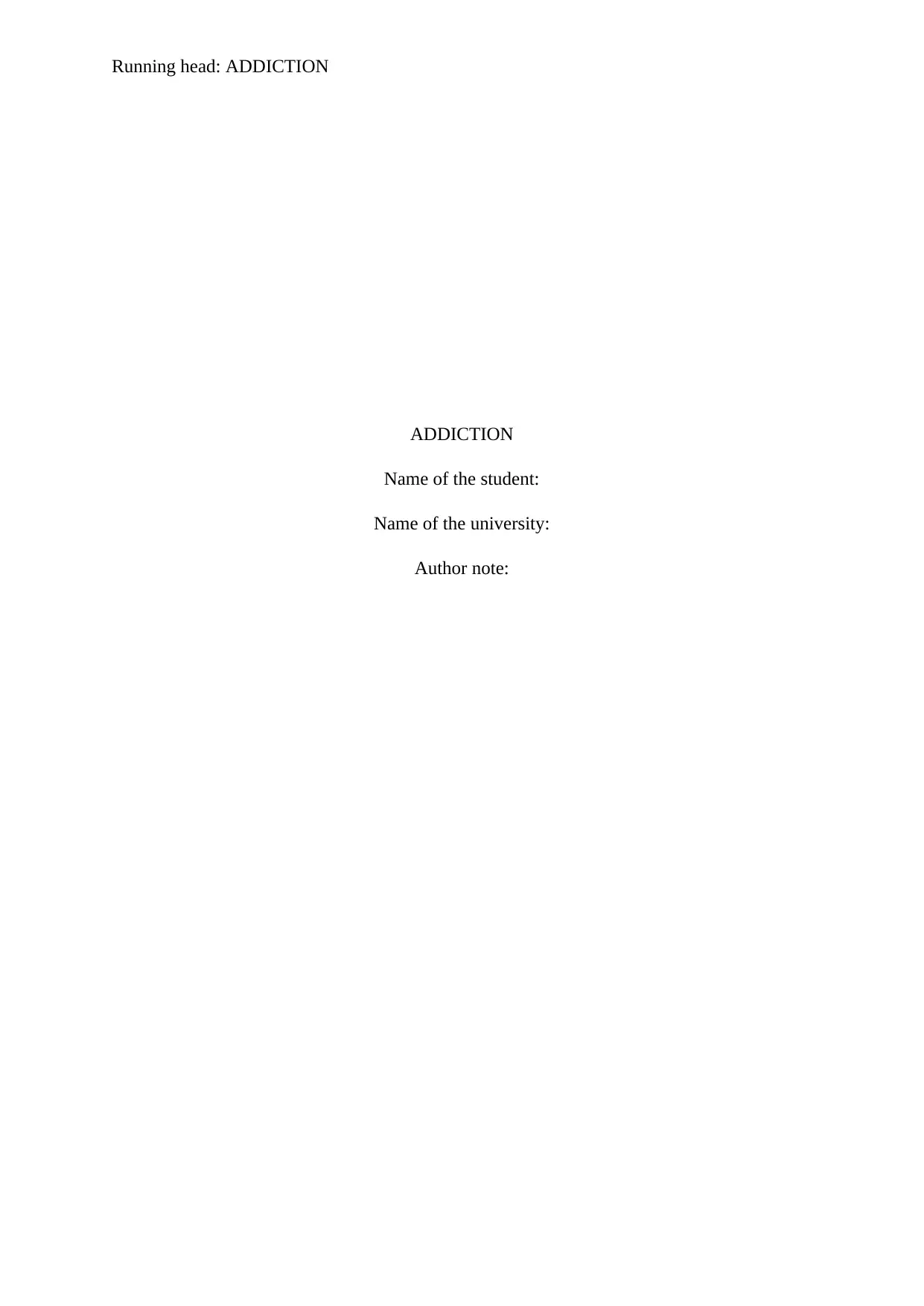
Running head: ADDICTION
ADDICTION
Name of the student:
Name of the university:
Author note:
ADDICTION
Name of the student:
Name of the university:
Author note:
Paraphrase This Document
Need a fresh take? Get an instant paraphrase of this document with our AI Paraphraser
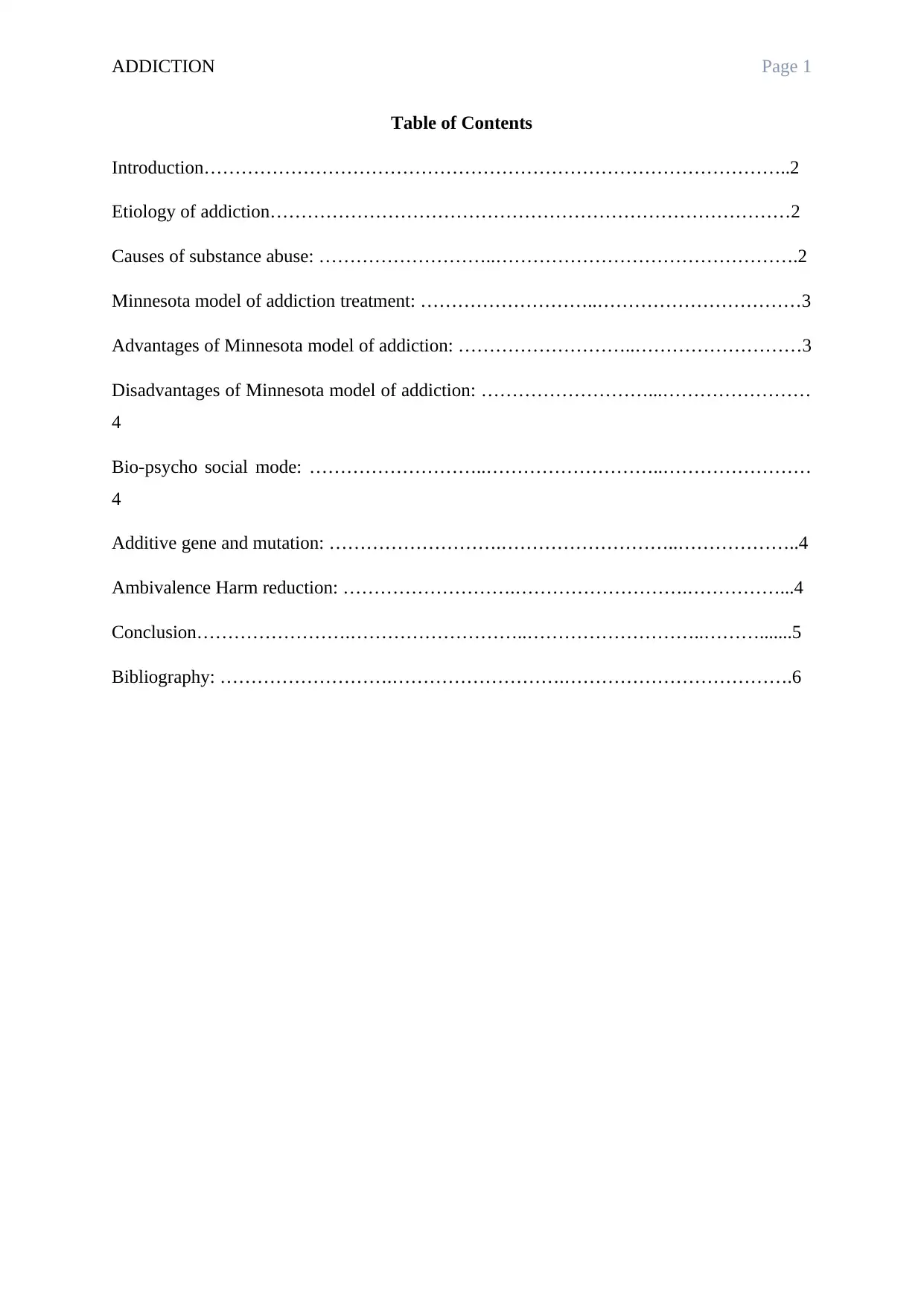
ADDICTION Page 1
Table of Contents
Introduction…………………………………………………………………………………..2
Etiology of addiction…………………………………………………………………………2
Causes of substance abuse: ………………………..………………………………………….2
Minnesota model of addiction treatment: ………………………..……………………………3
Advantages of Minnesota model of addiction: ………………………..………………………3
Disadvantages of Minnesota model of addiction: ………………………...……………………
4
Bio-psycho social mode: ………………………..………………………..……………………
4
Additive gene and mutation: ……………………….………………………..………………..4
Ambivalence Harm reduction: ……………………….……………………….……………...4
Conclusion…………………….………………………..………………………..……….......5
Bibliography: ……………………….……………………….……………………………….6
Table of Contents
Introduction…………………………………………………………………………………..2
Etiology of addiction…………………………………………………………………………2
Causes of substance abuse: ………………………..………………………………………….2
Minnesota model of addiction treatment: ………………………..……………………………3
Advantages of Minnesota model of addiction: ………………………..………………………3
Disadvantages of Minnesota model of addiction: ………………………...……………………
4
Bio-psycho social mode: ………………………..………………………..……………………
4
Additive gene and mutation: ……………………….………………………..………………..4
Ambivalence Harm reduction: ……………………….……………………….……………...4
Conclusion…………………….………………………..………………………..……….......5
Bibliography: ……………………….……………………….……………………………….6
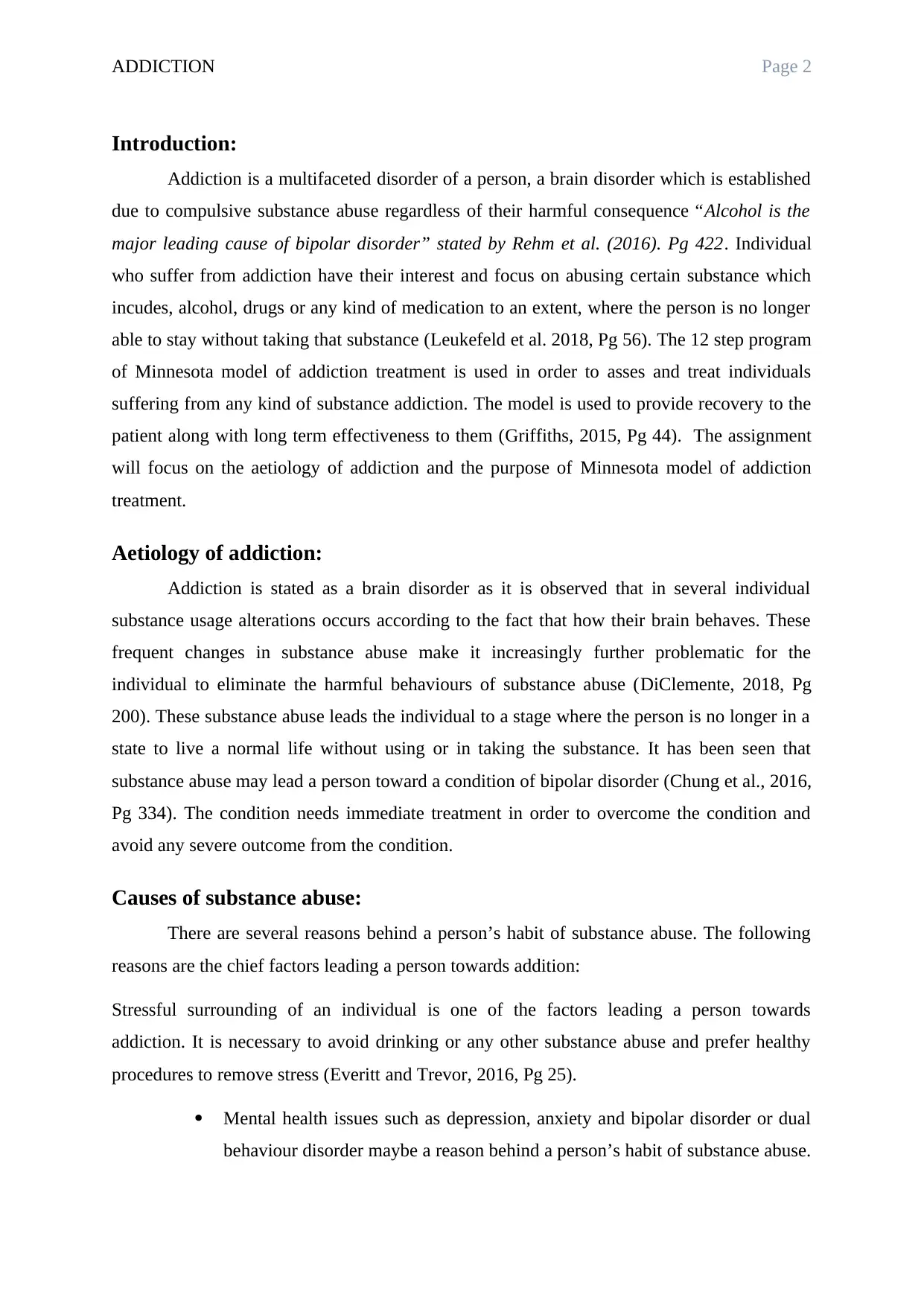
ADDICTION Page 2
Introduction:
Addiction is a multifaceted disorder of a person, a brain disorder which is established
due to compulsive substance abuse regardless of their harmful consequence “Alcohol is the
major leading cause of bipolar disorder” stated by Rehm et al. (2016). Pg 422. Individual
who suffer from addiction have their interest and focus on abusing certain substance which
incudes, alcohol, drugs or any kind of medication to an extent, where the person is no longer
able to stay without taking that substance (Leukefeld et al. 2018, Pg 56). The 12 step program
of Minnesota model of addiction treatment is used in order to asses and treat individuals
suffering from any kind of substance addiction. The model is used to provide recovery to the
patient along with long term effectiveness to them (Griffiths, 2015, Pg 44). The assignment
will focus on the aetiology of addiction and the purpose of Minnesota model of addiction
treatment.
Aetiology of addiction:
Addiction is stated as a brain disorder as it is observed that in several individual
substance usage alterations occurs according to the fact that how their brain behaves. These
frequent changes in substance abuse make it increasingly further problematic for the
individual to eliminate the harmful behaviours of substance abuse (DiClemente, 2018, Pg
200). These substance abuse leads the individual to a stage where the person is no longer in a
state to live a normal life without using or in taking the substance. It has been seen that
substance abuse may lead a person toward a condition of bipolar disorder (Chung et al., 2016,
Pg 334). The condition needs immediate treatment in order to overcome the condition and
avoid any severe outcome from the condition.
Causes of substance abuse:
There are several reasons behind a person’s habit of substance abuse. The following
reasons are the chief factors leading a person towards addition:
Stressful surrounding of an individual is one of the factors leading a person towards
addiction. It is necessary to avoid drinking or any other substance abuse and prefer healthy
procedures to remove stress (Everitt and Trevor, 2016, Pg 25).
Mental health issues such as depression, anxiety and bipolar disorder or dual
behaviour disorder maybe a reason behind a person’s habit of substance abuse.
Introduction:
Addiction is a multifaceted disorder of a person, a brain disorder which is established
due to compulsive substance abuse regardless of their harmful consequence “Alcohol is the
major leading cause of bipolar disorder” stated by Rehm et al. (2016). Pg 422. Individual
who suffer from addiction have their interest and focus on abusing certain substance which
incudes, alcohol, drugs or any kind of medication to an extent, where the person is no longer
able to stay without taking that substance (Leukefeld et al. 2018, Pg 56). The 12 step program
of Minnesota model of addiction treatment is used in order to asses and treat individuals
suffering from any kind of substance addiction. The model is used to provide recovery to the
patient along with long term effectiveness to them (Griffiths, 2015, Pg 44). The assignment
will focus on the aetiology of addiction and the purpose of Minnesota model of addiction
treatment.
Aetiology of addiction:
Addiction is stated as a brain disorder as it is observed that in several individual
substance usage alterations occurs according to the fact that how their brain behaves. These
frequent changes in substance abuse make it increasingly further problematic for the
individual to eliminate the harmful behaviours of substance abuse (DiClemente, 2018, Pg
200). These substance abuse leads the individual to a stage where the person is no longer in a
state to live a normal life without using or in taking the substance. It has been seen that
substance abuse may lead a person toward a condition of bipolar disorder (Chung et al., 2016,
Pg 334). The condition needs immediate treatment in order to overcome the condition and
avoid any severe outcome from the condition.
Causes of substance abuse:
There are several reasons behind a person’s habit of substance abuse. The following
reasons are the chief factors leading a person towards addition:
Stressful surrounding of an individual is one of the factors leading a person towards
addiction. It is necessary to avoid drinking or any other substance abuse and prefer healthy
procedures to remove stress (Everitt and Trevor, 2016, Pg 25).
Mental health issues such as depression, anxiety and bipolar disorder or dual
behaviour disorder maybe a reason behind a person’s habit of substance abuse.
⊘ This is a preview!⊘
Do you want full access?
Subscribe today to unlock all pages.

Trusted by 1+ million students worldwide
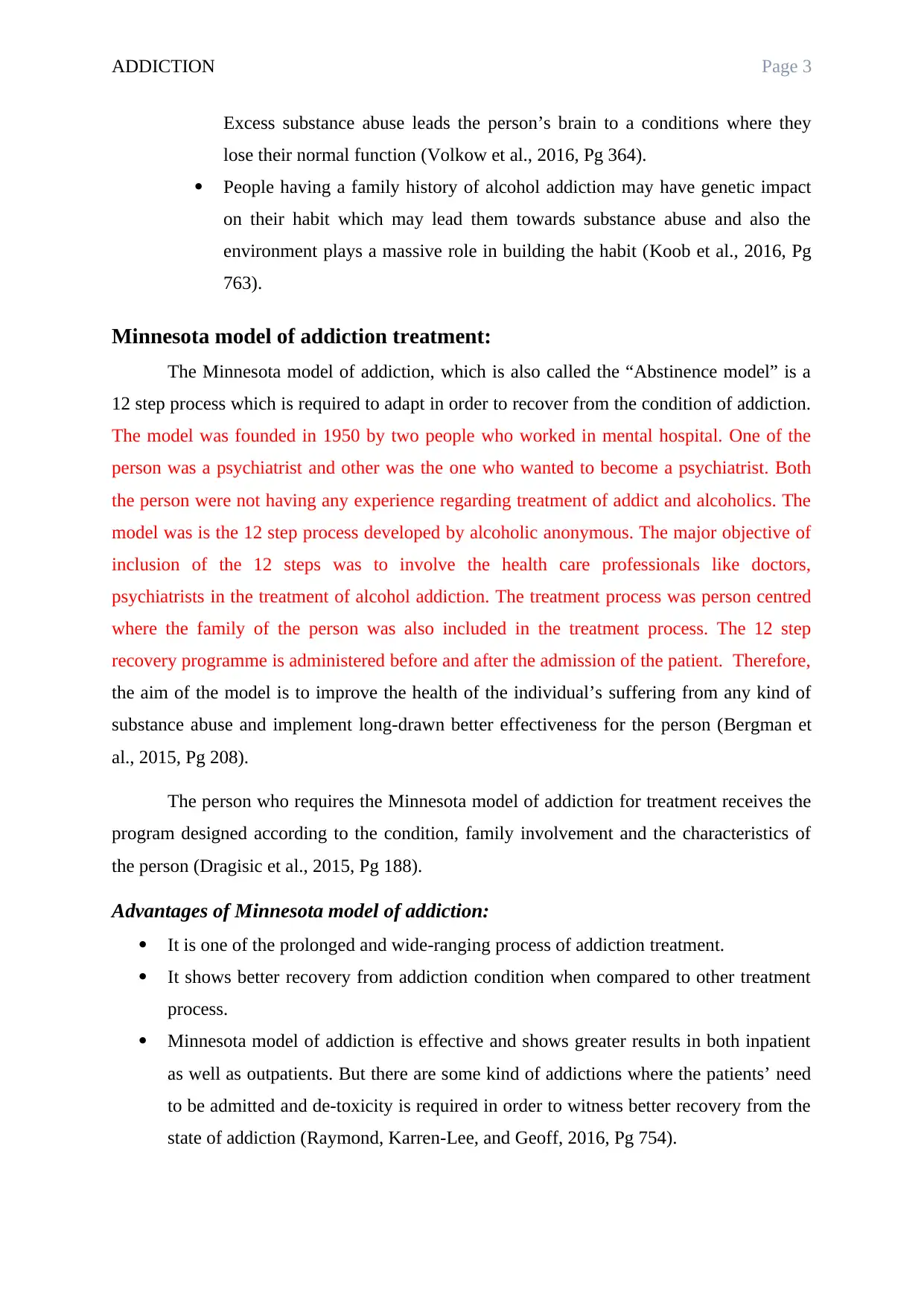
ADDICTION Page 3
Excess substance abuse leads the person’s brain to a conditions where they
lose their normal function (Volkow et al., 2016, Pg 364).
People having a family history of alcohol addiction may have genetic impact
on their habit which may lead them towards substance abuse and also the
environment plays a massive role in building the habit (Koob et al., 2016, Pg
763).
Minnesota model of addiction treatment:
The Minnesota model of addiction, which is also called the “Abstinence model” is a
12 step process which is required to adapt in order to recover from the condition of addiction.
The model was founded in 1950 by two people who worked in mental hospital. One of the
person was a psychiatrist and other was the one who wanted to become a psychiatrist. Both
the person were not having any experience regarding treatment of addict and alcoholics. The
model was is the 12 step process developed by alcoholic anonymous. The major objective of
inclusion of the 12 steps was to involve the health care professionals like doctors,
psychiatrists in the treatment of alcohol addiction. The treatment process was person centred
where the family of the person was also included in the treatment process. The 12 step
recovery programme is administered before and after the admission of the patient. Therefore,
the aim of the model is to improve the health of the individual’s suffering from any kind of
substance abuse and implement long-drawn better effectiveness for the person (Bergman et
al., 2015, Pg 208).
The person who requires the Minnesota model of addiction for treatment receives the
program designed according to the condition, family involvement and the characteristics of
the person (Dragisic et al., 2015, Pg 188).
Advantages of Minnesota model of addiction:
It is one of the prolonged and wide-ranging process of addiction treatment.
It shows better recovery from addiction condition when compared to other treatment
process.
Minnesota model of addiction is effective and shows greater results in both inpatient
as well as outpatients. But there are some kind of addictions where the patients’ need
to be admitted and de-toxicity is required in order to witness better recovery from the
state of addiction (Raymond, Karren-Lee, and Geoff, 2016, Pg 754).
Excess substance abuse leads the person’s brain to a conditions where they
lose their normal function (Volkow et al., 2016, Pg 364).
People having a family history of alcohol addiction may have genetic impact
on their habit which may lead them towards substance abuse and also the
environment plays a massive role in building the habit (Koob et al., 2016, Pg
763).
Minnesota model of addiction treatment:
The Minnesota model of addiction, which is also called the “Abstinence model” is a
12 step process which is required to adapt in order to recover from the condition of addiction.
The model was founded in 1950 by two people who worked in mental hospital. One of the
person was a psychiatrist and other was the one who wanted to become a psychiatrist. Both
the person were not having any experience regarding treatment of addict and alcoholics. The
model was is the 12 step process developed by alcoholic anonymous. The major objective of
inclusion of the 12 steps was to involve the health care professionals like doctors,
psychiatrists in the treatment of alcohol addiction. The treatment process was person centred
where the family of the person was also included in the treatment process. The 12 step
recovery programme is administered before and after the admission of the patient. Therefore,
the aim of the model is to improve the health of the individual’s suffering from any kind of
substance abuse and implement long-drawn better effectiveness for the person (Bergman et
al., 2015, Pg 208).
The person who requires the Minnesota model of addiction for treatment receives the
program designed according to the condition, family involvement and the characteristics of
the person (Dragisic et al., 2015, Pg 188).
Advantages of Minnesota model of addiction:
It is one of the prolonged and wide-ranging process of addiction treatment.
It shows better recovery from addiction condition when compared to other treatment
process.
Minnesota model of addiction is effective and shows greater results in both inpatient
as well as outpatients. But there are some kind of addictions where the patients’ need
to be admitted and de-toxicity is required in order to witness better recovery from the
state of addiction (Raymond, Karren-Lee, and Geoff, 2016, Pg 754).
Paraphrase This Document
Need a fresh take? Get an instant paraphrase of this document with our AI Paraphraser
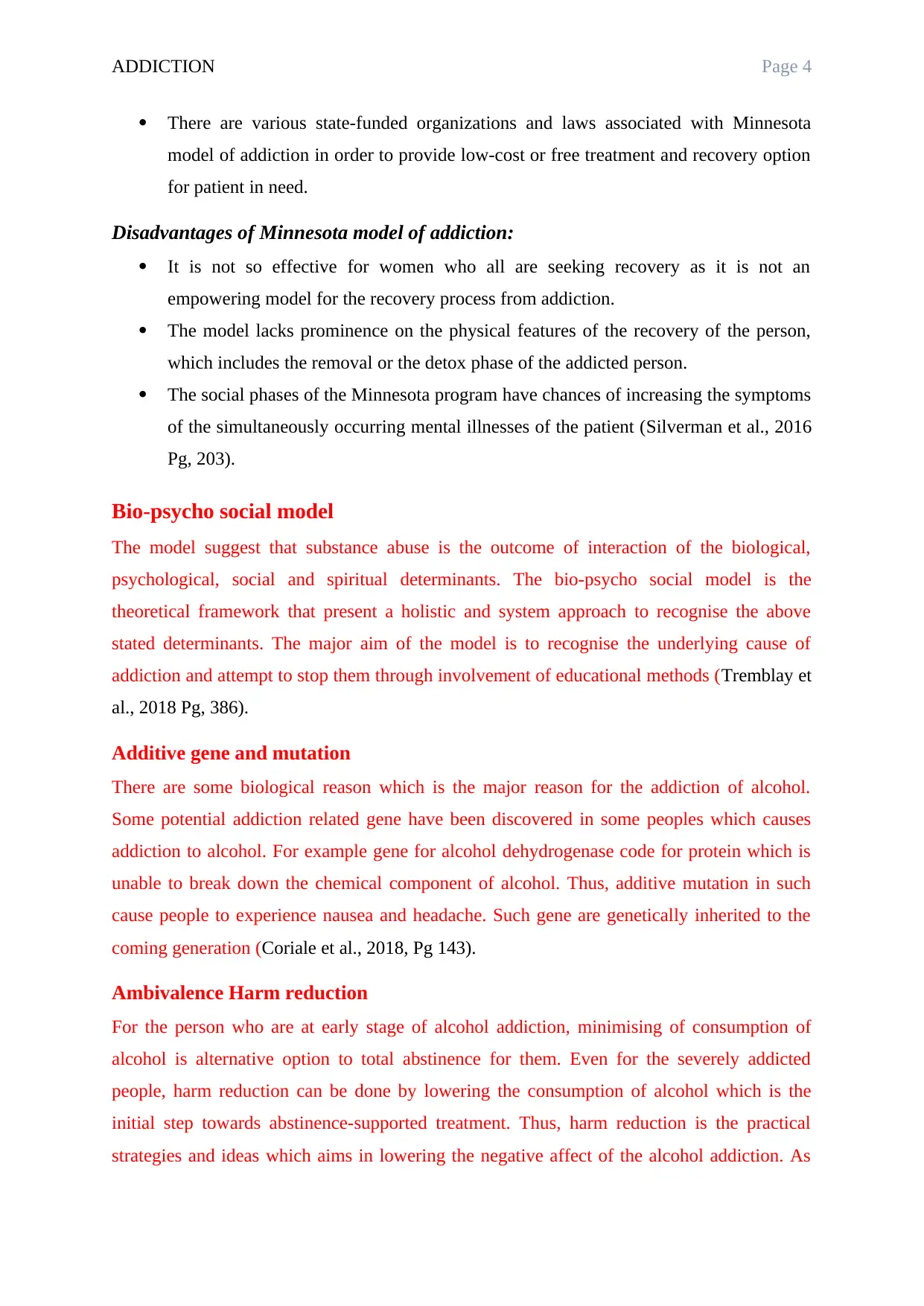
ADDICTION Page 4
There are various state-funded organizations and laws associated with Minnesota
model of addiction in order to provide low-cost or free treatment and recovery option
for patient in need.
Disadvantages of Minnesota model of addiction:
It is not so effective for women who all are seeking recovery as it is not an
empowering model for the recovery process from addiction.
The model lacks prominence on the physical features of the recovery of the person,
which includes the removal or the detox phase of the addicted person.
The social phases of the Minnesota program have chances of increasing the symptoms
of the simultaneously occurring mental illnesses of the patient (Silverman et al., 2016
Pg, 203).
Bio-psycho social model
The model suggest that substance abuse is the outcome of interaction of the biological,
psychological, social and spiritual determinants. The bio-psycho social model is the
theoretical framework that present a holistic and system approach to recognise the above
stated determinants. The major aim of the model is to recognise the underlying cause of
addiction and attempt to stop them through involvement of educational methods (Tremblay et
al., 2018 Pg, 386).
Additive gene and mutation
There are some biological reason which is the major reason for the addiction of alcohol.
Some potential addiction related gene have been discovered in some peoples which causes
addiction to alcohol. For example gene for alcohol dehydrogenase code for protein which is
unable to break down the chemical component of alcohol. Thus, additive mutation in such
cause people to experience nausea and headache. Such gene are genetically inherited to the
coming generation (Coriale et al., 2018, Pg 143).
Ambivalence Harm reduction
For the person who are at early stage of alcohol addiction, minimising of consumption of
alcohol is alternative option to total abstinence for them. Even for the severely addicted
people, harm reduction can be done by lowering the consumption of alcohol which is the
initial step towards abstinence-supported treatment. Thus, harm reduction is the practical
strategies and ideas which aims in lowering the negative affect of the alcohol addiction. As
There are various state-funded organizations and laws associated with Minnesota
model of addiction in order to provide low-cost or free treatment and recovery option
for patient in need.
Disadvantages of Minnesota model of addiction:
It is not so effective for women who all are seeking recovery as it is not an
empowering model for the recovery process from addiction.
The model lacks prominence on the physical features of the recovery of the person,
which includes the removal or the detox phase of the addicted person.
The social phases of the Minnesota program have chances of increasing the symptoms
of the simultaneously occurring mental illnesses of the patient (Silverman et al., 2016
Pg, 203).
Bio-psycho social model
The model suggest that substance abuse is the outcome of interaction of the biological,
psychological, social and spiritual determinants. The bio-psycho social model is the
theoretical framework that present a holistic and system approach to recognise the above
stated determinants. The major aim of the model is to recognise the underlying cause of
addiction and attempt to stop them through involvement of educational methods (Tremblay et
al., 2018 Pg, 386).
Additive gene and mutation
There are some biological reason which is the major reason for the addiction of alcohol.
Some potential addiction related gene have been discovered in some peoples which causes
addiction to alcohol. For example gene for alcohol dehydrogenase code for protein which is
unable to break down the chemical component of alcohol. Thus, additive mutation in such
cause people to experience nausea and headache. Such gene are genetically inherited to the
coming generation (Coriale et al., 2018, Pg 143).
Ambivalence Harm reduction
For the person who are at early stage of alcohol addiction, minimising of consumption of
alcohol is alternative option to total abstinence for them. Even for the severely addicted
people, harm reduction can be done by lowering the consumption of alcohol which is the
initial step towards abstinence-supported treatment. Thus, harm reduction is the practical
strategies and ideas which aims in lowering the negative affect of the alcohol addiction. As
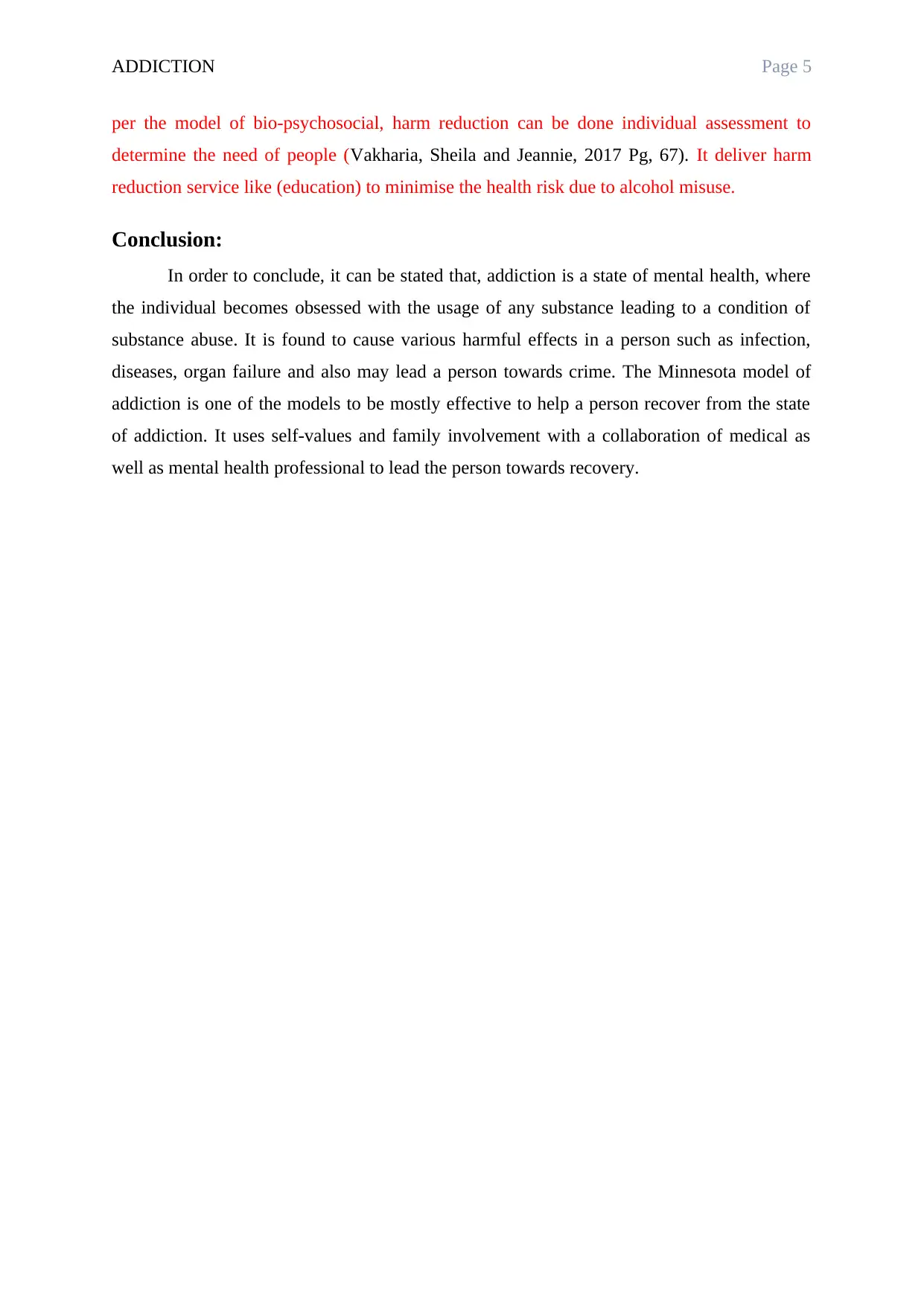
ADDICTION Page 5
per the model of bio-psychosocial, harm reduction can be done individual assessment to
determine the need of people (Vakharia, Sheila and Jeannie, 2017 Pg, 67). It deliver harm
reduction service like (education) to minimise the health risk due to alcohol misuse.
Conclusion:
In order to conclude, it can be stated that, addiction is a state of mental health, where
the individual becomes obsessed with the usage of any substance leading to a condition of
substance abuse. It is found to cause various harmful effects in a person such as infection,
diseases, organ failure and also may lead a person towards crime. The Minnesota model of
addiction is one of the models to be mostly effective to help a person recover from the state
of addiction. It uses self-values and family involvement with a collaboration of medical as
well as mental health professional to lead the person towards recovery.
per the model of bio-psychosocial, harm reduction can be done individual assessment to
determine the need of people (Vakharia, Sheila and Jeannie, 2017 Pg, 67). It deliver harm
reduction service like (education) to minimise the health risk due to alcohol misuse.
Conclusion:
In order to conclude, it can be stated that, addiction is a state of mental health, where
the individual becomes obsessed with the usage of any substance leading to a condition of
substance abuse. It is found to cause various harmful effects in a person such as infection,
diseases, organ failure and also may lead a person towards crime. The Minnesota model of
addiction is one of the models to be mostly effective to help a person recover from the state
of addiction. It uses self-values and family involvement with a collaboration of medical as
well as mental health professional to lead the person towards recovery.
⊘ This is a preview!⊘
Do you want full access?
Subscribe today to unlock all pages.

Trusted by 1+ million students worldwide
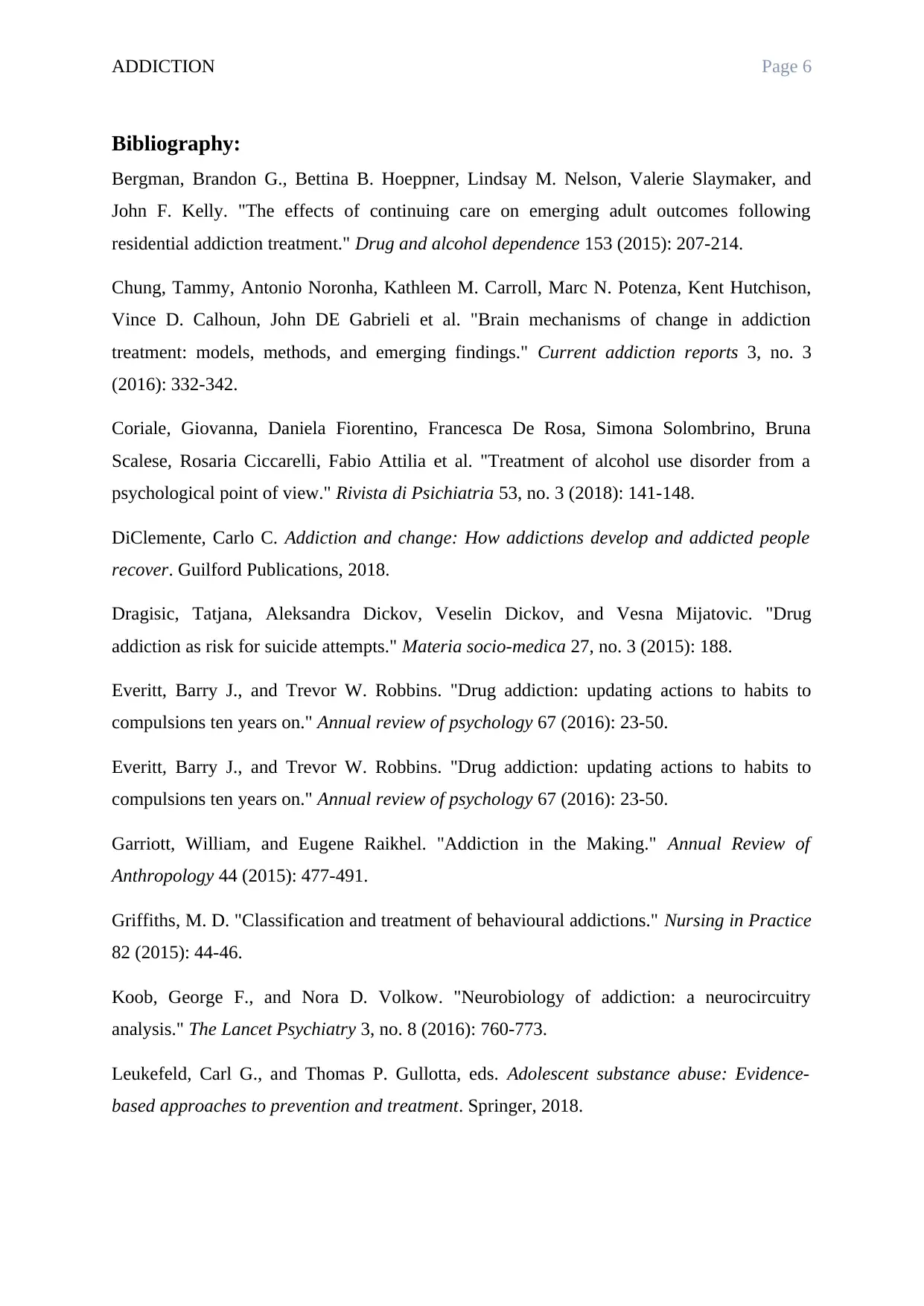
ADDICTION Page 6
Bibliography:
Bergman, Brandon G., Bettina B. Hoeppner, Lindsay M. Nelson, Valerie Slaymaker, and
John F. Kelly. "The effects of continuing care on emerging adult outcomes following
residential addiction treatment." Drug and alcohol dependence 153 (2015): 207-214.
Chung, Tammy, Antonio Noronha, Kathleen M. Carroll, Marc N. Potenza, Kent Hutchison,
Vince D. Calhoun, John DE Gabrieli et al. "Brain mechanisms of change in addiction
treatment: models, methods, and emerging findings." Current addiction reports 3, no. 3
(2016): 332-342.
Coriale, Giovanna, Daniela Fiorentino, Francesca De Rosa, Simona Solombrino, Bruna
Scalese, Rosaria Ciccarelli, Fabio Attilia et al. "Treatment of alcohol use disorder from a
psychological point of view." Rivista di Psichiatria 53, no. 3 (2018): 141-148.
DiClemente, Carlo C. Addiction and change: How addictions develop and addicted people
recover. Guilford Publications, 2018.
Dragisic, Tatjana, Aleksandra Dickov, Veselin Dickov, and Vesna Mijatovic. "Drug
addiction as risk for suicide attempts." Materia socio-medica 27, no. 3 (2015): 188.
Everitt, Barry J., and Trevor W. Robbins. "Drug addiction: updating actions to habits to
compulsions ten years on." Annual review of psychology 67 (2016): 23-50.
Everitt, Barry J., and Trevor W. Robbins. "Drug addiction: updating actions to habits to
compulsions ten years on." Annual review of psychology 67 (2016): 23-50.
Garriott, William, and Eugene Raikhel. "Addiction in the Making." Annual Review of
Anthropology 44 (2015): 477-491.
Griffiths, M. D. "Classification and treatment of behavioural addictions." Nursing in Practice
82 (2015): 44-46.
Koob, George F., and Nora D. Volkow. "Neurobiology of addiction: a neurocircuitry
analysis." The Lancet Psychiatry 3, no. 8 (2016): 760-773.
Leukefeld, Carl G., and Thomas P. Gullotta, eds. Adolescent substance abuse: Evidence-
based approaches to prevention and treatment. Springer, 2018.
Bibliography:
Bergman, Brandon G., Bettina B. Hoeppner, Lindsay M. Nelson, Valerie Slaymaker, and
John F. Kelly. "The effects of continuing care on emerging adult outcomes following
residential addiction treatment." Drug and alcohol dependence 153 (2015): 207-214.
Chung, Tammy, Antonio Noronha, Kathleen M. Carroll, Marc N. Potenza, Kent Hutchison,
Vince D. Calhoun, John DE Gabrieli et al. "Brain mechanisms of change in addiction
treatment: models, methods, and emerging findings." Current addiction reports 3, no. 3
(2016): 332-342.
Coriale, Giovanna, Daniela Fiorentino, Francesca De Rosa, Simona Solombrino, Bruna
Scalese, Rosaria Ciccarelli, Fabio Attilia et al. "Treatment of alcohol use disorder from a
psychological point of view." Rivista di Psichiatria 53, no. 3 (2018): 141-148.
DiClemente, Carlo C. Addiction and change: How addictions develop and addicted people
recover. Guilford Publications, 2018.
Dragisic, Tatjana, Aleksandra Dickov, Veselin Dickov, and Vesna Mijatovic. "Drug
addiction as risk for suicide attempts." Materia socio-medica 27, no. 3 (2015): 188.
Everitt, Barry J., and Trevor W. Robbins. "Drug addiction: updating actions to habits to
compulsions ten years on." Annual review of psychology 67 (2016): 23-50.
Everitt, Barry J., and Trevor W. Robbins. "Drug addiction: updating actions to habits to
compulsions ten years on." Annual review of psychology 67 (2016): 23-50.
Garriott, William, and Eugene Raikhel. "Addiction in the Making." Annual Review of
Anthropology 44 (2015): 477-491.
Griffiths, M. D. "Classification and treatment of behavioural addictions." Nursing in Practice
82 (2015): 44-46.
Koob, George F., and Nora D. Volkow. "Neurobiology of addiction: a neurocircuitry
analysis." The Lancet Psychiatry 3, no. 8 (2016): 760-773.
Leukefeld, Carl G., and Thomas P. Gullotta, eds. Adolescent substance abuse: Evidence-
based approaches to prevention and treatment. Springer, 2018.
Paraphrase This Document
Need a fresh take? Get an instant paraphrase of this document with our AI Paraphraser
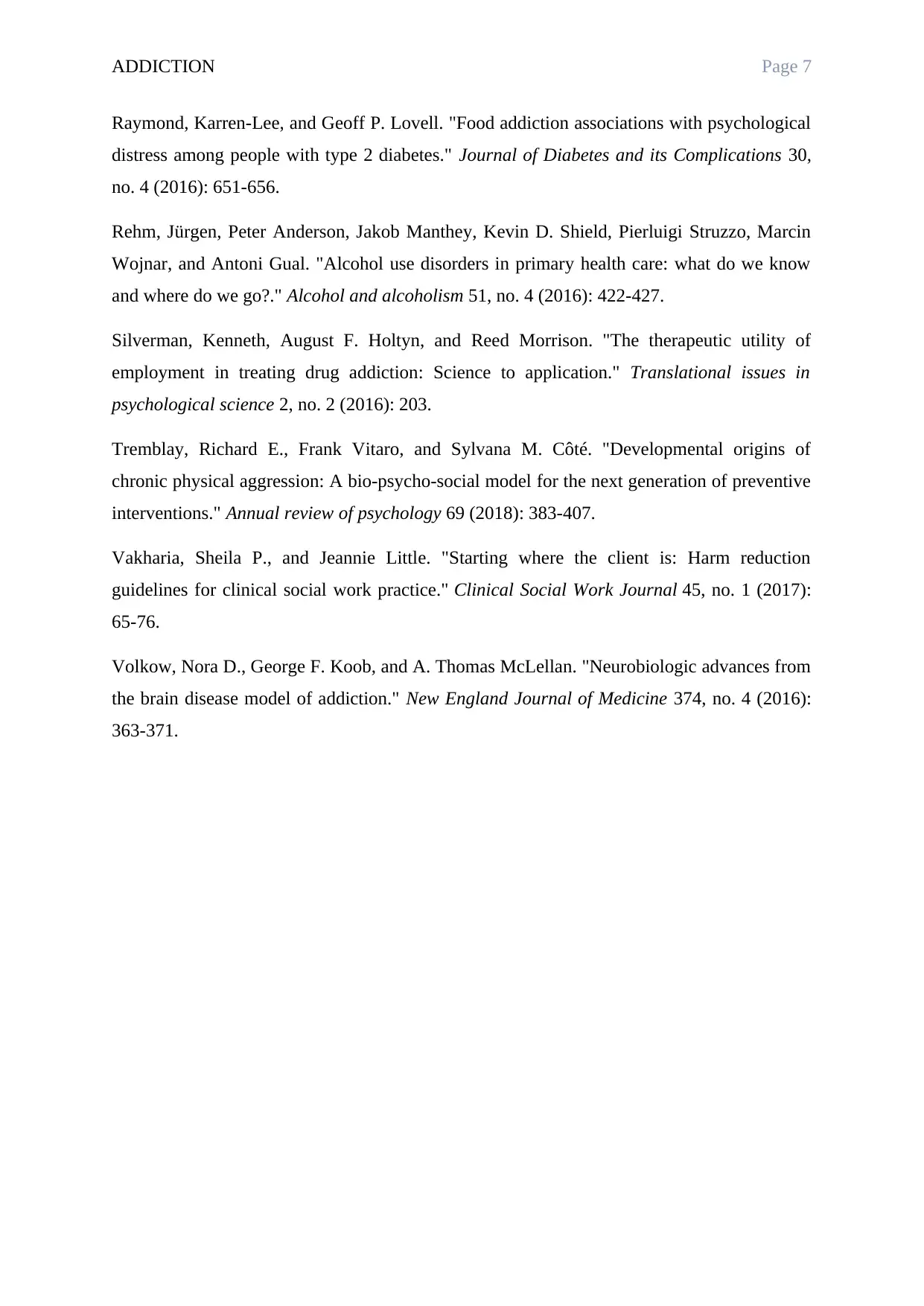
ADDICTION Page 7
Raymond, Karren-Lee, and Geoff P. Lovell. "Food addiction associations with psychological
distress among people with type 2 diabetes." Journal of Diabetes and its Complications 30,
no. 4 (2016): 651-656.
Rehm, Jürgen, Peter Anderson, Jakob Manthey, Kevin D. Shield, Pierluigi Struzzo, Marcin
Wojnar, and Antoni Gual. "Alcohol use disorders in primary health care: what do we know
and where do we go?." Alcohol and alcoholism 51, no. 4 (2016): 422-427.
Silverman, Kenneth, August F. Holtyn, and Reed Morrison. "The therapeutic utility of
employment in treating drug addiction: Science to application." Translational issues in
psychological science 2, no. 2 (2016): 203.
Tremblay, Richard E., Frank Vitaro, and Sylvana M. Côté. "Developmental origins of
chronic physical aggression: A bio-psycho-social model for the next generation of preventive
interventions." Annual review of psychology 69 (2018): 383-407.
Vakharia, Sheila P., and Jeannie Little. "Starting where the client is: Harm reduction
guidelines for clinical social work practice." Clinical Social Work Journal 45, no. 1 (2017):
65-76.
Volkow, Nora D., George F. Koob, and A. Thomas McLellan. "Neurobiologic advances from
the brain disease model of addiction." New England Journal of Medicine 374, no. 4 (2016):
363-371.
Raymond, Karren-Lee, and Geoff P. Lovell. "Food addiction associations with psychological
distress among people with type 2 diabetes." Journal of Diabetes and its Complications 30,
no. 4 (2016): 651-656.
Rehm, Jürgen, Peter Anderson, Jakob Manthey, Kevin D. Shield, Pierluigi Struzzo, Marcin
Wojnar, and Antoni Gual. "Alcohol use disorders in primary health care: what do we know
and where do we go?." Alcohol and alcoholism 51, no. 4 (2016): 422-427.
Silverman, Kenneth, August F. Holtyn, and Reed Morrison. "The therapeutic utility of
employment in treating drug addiction: Science to application." Translational issues in
psychological science 2, no. 2 (2016): 203.
Tremblay, Richard E., Frank Vitaro, and Sylvana M. Côté. "Developmental origins of
chronic physical aggression: A bio-psycho-social model for the next generation of preventive
interventions." Annual review of psychology 69 (2018): 383-407.
Vakharia, Sheila P., and Jeannie Little. "Starting where the client is: Harm reduction
guidelines for clinical social work practice." Clinical Social Work Journal 45, no. 1 (2017):
65-76.
Volkow, Nora D., George F. Koob, and A. Thomas McLellan. "Neurobiologic advances from
the brain disease model of addiction." New England Journal of Medicine 374, no. 4 (2016):
363-371.
1 out of 8
Related Documents
Your All-in-One AI-Powered Toolkit for Academic Success.
+13062052269
info@desklib.com
Available 24*7 on WhatsApp / Email
![[object Object]](/_next/static/media/star-bottom.7253800d.svg)
Unlock your academic potential
Copyright © 2020–2025 A2Z Services. All Rights Reserved. Developed and managed by ZUCOL.





